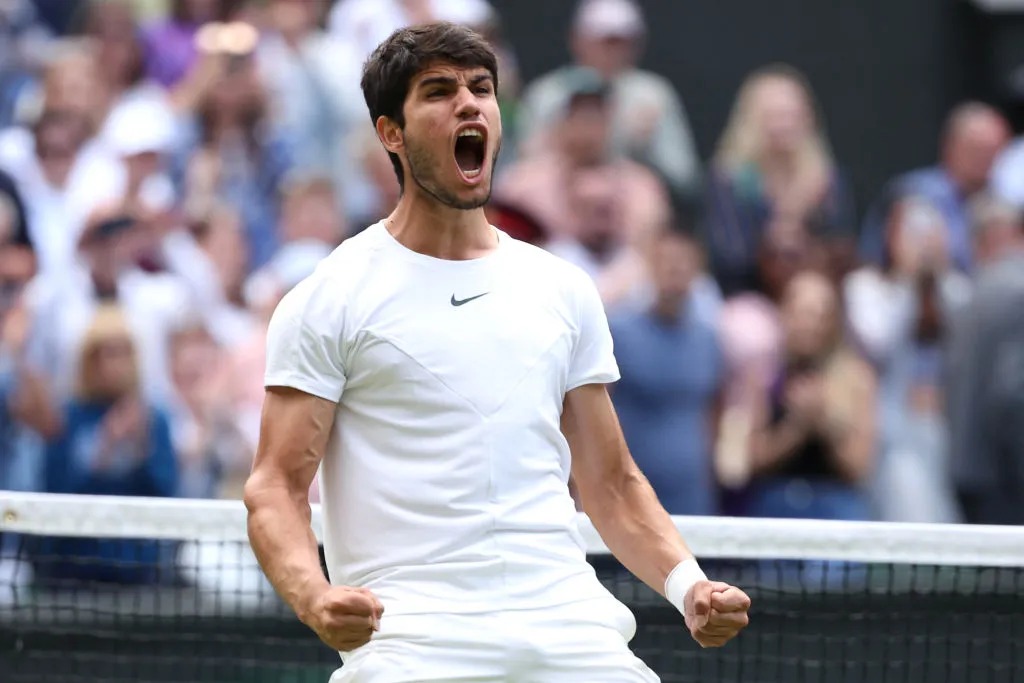For a sports aficionado, the brain is akin to a cupboard that stores innumerable memories of heartbreaks and triumphs, alongside breathtaking shots and some head-scratching errors. On a pleasant day, at SW19, Carlos Alcaraz Garfia’s mental fortitude and tennis skills touched such a high level that you perhaps have to carve out some extra memory space to store and reminisce some of the rallies on display. To dethrone a player, who hadn’t lost a match at Wimbledon Centre Court for 10 years or 3661 days, it needed someone to scale never-seen-before heights. The 20-year-old Alcaraz certainly did that, and was duly rewarded with the coveted Wimbledon Trophy.
If we turn the pages, it didn’t seem as if the match would turn out to be an all time classic, with Djokovic winning the opening set comfortably 6-1. The Serb’s returns had depth as he put pressure on Alcaraz. The resultant outcome was the 20-year-old couldn’t really move forward as he made only 4 approaches to the net. At that juncture of the match, Alcaraz had said to himself, ‘Carlos, increase the level, everyone will be disappointed.’
Alcaraz surely walked the talk in the second set as he broke the experienced player’s serve early, only to be broken back. Djokovic still seemed to have the upper hand in relation to long rallies, exemplified by the 29-shot rally at 1-2. Ultimately, the second set went into a tie-break. Alcaraz had a daunting task ahead of him as Djokovic was eying his 15th straight tie-break win in Grand Slams. Alcaraz was even broken early, but he served well and it was back on level terms as Djokovic netted a slice. Under pressure, Djokovic had chosen the wrong option. Yes, it tells you even the best do crack a bit under pressure.
Alcaraz soon gained some ground in the crucial tie-break as he employed the monstrous forehand. And there was also a superbly-disguised drop shot. Initially, the drop shot seemed more like a forehand before he outmanoeuvred Djokovic with great hands. Eventually, Djokovic lost a tie-break on the back of a potentially game-changing down-the-line backhand winner from Alcaraz. It was quite clear that Djokovic was getting a taste of his own medicine – winners being slammed by his opponent from the backhand side.
Subsequently, Alcaraz ran away with the third set. By then, Alcaraz’s forehand was making enough holes in Djokovic’s game as he gained a break. It was at 3-1, in the second set, when it felt as if Alacarz might actually go on to hoist the trophy. In a game that lasted over 25 minutes and had 13 deuces, it was Alcaraz who finally held his nerve and nailed the second break, with another of his bazooka backhands. Djokovic generally wins a game when it turns out to be a war of attrition. Alcaraz, though, seemed to be playing with the intensity of Djokovic’s long-time rival and his countryman, Rafael Nadal. Meanwhile, Djokovic made as many as 18 unforced errors and his serve too wasn’t making much of an impression on his opponent.
Djokovic, renowned for never giving up, bounced back by taking the fourth set 6-3, breaking his opponent twice in the process. In the last set, it was at 0-1, on serve, when Alcaraz once again made a statement – that he is here to outlast Djokovic and win. After not being able to convert a break point, Alcaraz was down a break on his own serve. However, he ran around like jackrabbit and that resulted in Djokovic netting a forehand drive volley into the net. The old adage in tennis – make your opponent play one extra shot – worked for Alcaraz.
Alcaraz soon went for the kill by breaking the seven-time Wimbledon champion to make it 3-1. The way he wrongfooted his opponent with a backhand, and closed out the game with one of his quintessential down-the-line backhand winners, were clear signs of a shift in momentum. Djokovic would have still believed in scripting a jailbreak. Alcaraz, though, was nerveless as he landed his kick serves with precision and speed, alongside a mixture of forehands, backhands and a lunging backhand volley. Meanwhile, in perhaps sheer frustration, Djokovic smashed his racquet.
The destiny was surely not going to deny Alcaraz’s moment in the sun. At 5-4, 40-30, he moved towards the net with a cross-court forehand and forced Djokovic into making an error. Emotions flowed as Alcaraz collapsed onto the hallowed grass of Wimbledon. The young Spaniard also jumped over to his box to celebrate the moment. During the trophy presentation ceremony, a beaming Alcaraz aptly said, “the happiest moment of my life”.
So is Alcaraz the new king of tennis? He certainly possesses all the shots, evidenced by how he stunned Djokovic with his sliding backhands – both DTL and cross-court. If you had done a simple Google search before the summit clash, you would have excavated enough information about Alcaraz’s ballistic forehand. But in the Wimbledon final, it was Alcaraz’s backhand that won him some vital points. In fact, it is perhaps for the first time in the last 12-13 years that Djokovic was upstaged on the backhand side by an opponent.
Alcaraz has a very good serve. He is also quite adept at the net and comes across as an athlete. More than enough words have been penned about his forehand and how he takes the ball early. When needed, Alcaraz can do some heavy-hitting and has excellent defensive skills. And more importantly, he he has the mentality of a champion who never gives up. Simply put, his game feels like an amalgamation of the Big 3 of tennis – Djokovic, Nadal and Federer.
Djokovic succinctly observed in the post-match press conference. “He’s got this mental resilience and really maturity for someone who is 20 years old. It’s quite impressive. He’s got this Spanish bull mentality of competitiveness and fighting spirit and incredible defence that we’ve seen with Rafa over the years. And I think he’s got some nice sliding backhands that he’s got some similarities with my backhands. The two-handed backhands, defence, being able to adapt. I think that has been my personal strength for many years. He has it, too.
“I haven’t played a player like him ever, to be honest. Roger and Rafa have their own obvious strengths and weaknesses. Carlos is a very complete player. Amazing adapting capabilities that I think are a key for longevity and for a successful career on all surfaces.”
It is true that Alcaraz has a very long way to go before being compared to the greats of the game. But the 20-year-old has the required key tools along with ancillary parts to emulate the achievements of his hero, who too hails from Spain. It is perhaps the dawn of a new era in the world of men’s tennis.





